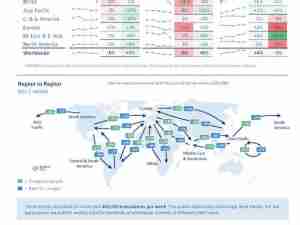Aviation’s Global Hub Is Quitting the Persian Gulf
By: | Jul 28 2017 at 02:13 AM | Air Cargo
Once upon a time, airlines based in the Persian Gulf were making all the running in the global aviation market.
Propped up by state owners that didn’t care too much about profits and blessed with a unique geographical position from which a single flight can reach almost every inhabited spot on the planet, Emirates, Etihad Airways PJSC and Qatar Airways Ltd. seemed to have the world at their feet.
Emirates was expanding capacity at the rate of 30 million or so available seat kilometers per year—roughly equivalent to adding an AirAsia Bhd. to its network every 12 months—and striking deals with weakened rivals such as Qantas Airways Ltd. to win more long-haul traffic.
Etihad was even busier, taking equity stakes in more than half a dozen airlines to build a rival to the traditional aviation groups of OneWorld, SkyTeam and Star Alliance—one that carried almost 127 million passengers last year.
Qatar Airways was moving in the same direction, becoming the biggest shareholder in IAG SA, the owner of British Airways, and South America’s largest operator, Latam Airlines Group SA. For good measure, Qatar’s sovereign wealth fund even bought a 20 percent stake in Heathrow Airport Holdings Ltd., owner of the busiest airport for international passengers after Dubai.
With remarkable speed, that advance is falling into disarray.
Etihad announced Thursday a $1.87 billion loss for its 2017 fiscal year, driven by massive writedowns in the value of those equity partners and its aircraft fleet. Even by the standards of the aviation industry, where fleet impairments can often spark dramatic numbers of this sort, that’s a giant of a loss.
Qatar Airways, meanwhile, could lose 30 percent of its revenue due to the blockade of its home country by its Arab neighbors, according to Frost & Sullivan, a consultancy, while Emirates in May reported its first annual profit decline in five years.
There are short- and long-term factors driving this. U.S. airlines, revived by a wave of domestic consolidation and seeking payback for the decades when Gulf carriers kept them on the back foot on international routes, have been using the government to exact revenge.
Restrictions on travel from Muslim-majority countries and a ban on laptops from Middle Eastern airports—the latter finally lifted in the past month, thanks to enhanced security measures—have chilled the activities of the Gulf carriers into the U.S. Etihad scrapped flights to San Francisco last month and Emirates has cut 25 weekly services to the country.
While those crises, and the blockade on Qatar, may gradually pass, it’s the longer-term picture that’s more worrying.
Delta/China Eastern stakes in Air France: 10% each
Consider the other big aviation news Thursday. Delta Air Lines Inc. and China Eastern Airlines Corp. paid about 751 million euros ($876 million) to each take 10 percent stakes in Air France-KLM, with the European group using some of the cash to buy a 31 percent stake in Virgin Atlantic Airways Ltd. Alitalia SpA, which counts Etihad as a 49 percent investor and was declared insolvent in May, will also be brought into the joint venture.
This sort of new alliance—cemented by market power on the big bilateral routes between the EU, the U.S. and China, and dominated by players in those markets—poses a profound threat to the vision of aviation’s future promulgated by the Gulf carriers.
A domestic market, after all, provides a formidable advantage for international carriers. Domestic passengers tend to pay more for each kilometer flown than international travelers, allowing the short-haul routes to subsidize the more competitive long-haul legs. They also provide feeder traffic so that planes from Chicago to London can be filled up with passengers ultimately traveling from Cincinnati to Glasgow, further improving profitability.
The Gulf carriers—all based in jurisdictions that are, in essence, city-states—lack that advantage. For most of the history of modern aviation, the geographical benefits of being global hub carriers has compensated for that handicap. That era, along with the double-decker jumbo jets that drove it, is now fading into the sunset with new aircraft that can fly further than their predecessors.
A future based on the power of the three big outbound tourism markets, rather than the strategic locations of global hubs, was always going to be challenging for the Gulf’s carriers. It could be arriving at the gate sooner than anyone expected.
This column does not necessarily reflect the opinion of Bloomberg LP and its owners.
